|
|
|
Sept 28, 2018 21:07:57 GMT
|
Thanks man  glad you're enjoying it. Managed to get the first two coats of primer on it today and... ...it's flat! 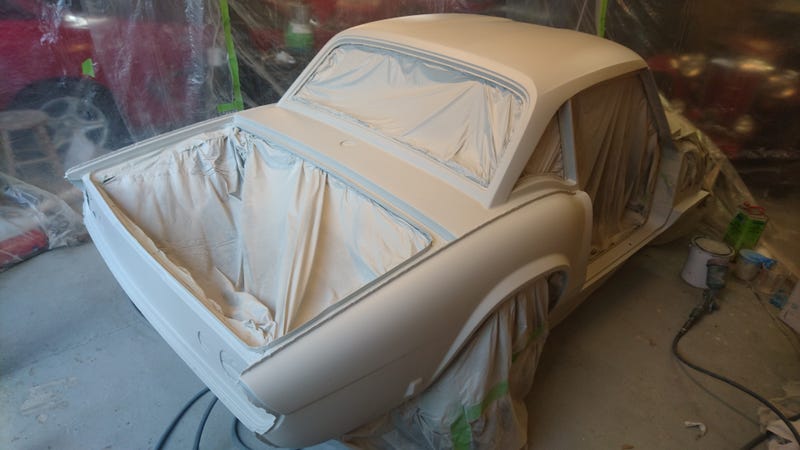 All my filling and sanding wasn’t for nothing  I have learnt I was mixing the filler too rigarously, introducing bubbles which cause little pinholes, but I'm hoping to fix that with a smidge more filler. Went ok apart from that  |
| |
|
|
|
|
|
|
|
|
|
And we have paint!  To try and avoid orange peel I put the paint on a little thicker than with the primer. Worked beautifully on most areas as it's glass smooth. Worked terribly on areas where I had overspray from other panels. Runs galore there. Looks like I've got more sanding to do. Currently weighing up whether to try and sand them out and back up to gloss, or sand them out and do one final coat of paint. Oh, and oddly this pic is nothing like the actual colour. This is closer to what it actually looks like in the sun: 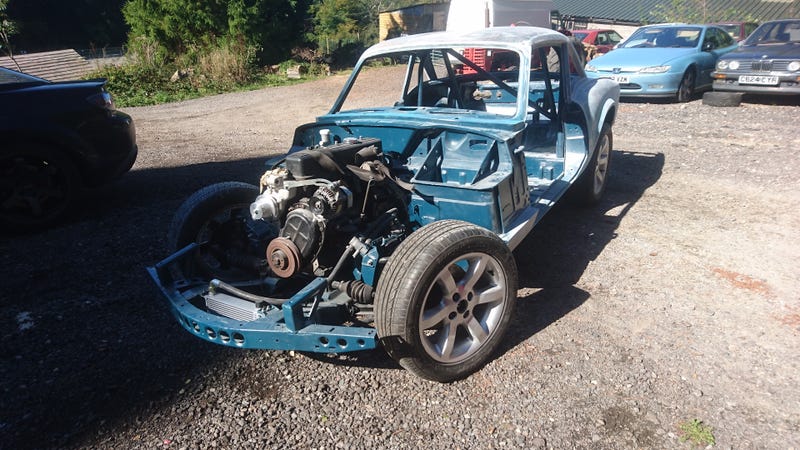 |
| |
|
|
|
|
|
|
|
Y'know what's depressing? 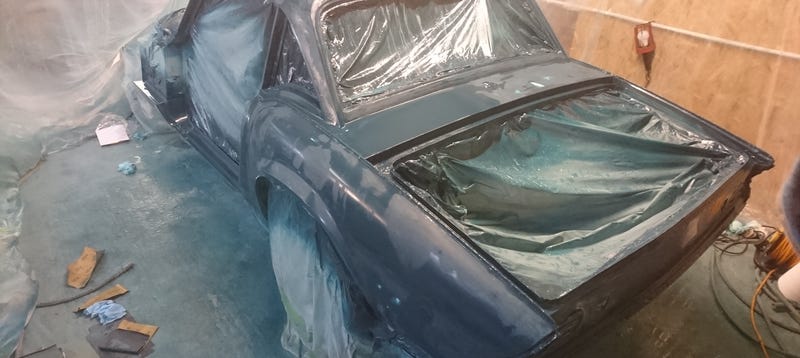 Block sanding lovely glossy paint because you weren't anal enough about cleaning dust and went too heavy on vertical surfaces and got runs. This I do not like... |
| |
|
|
Clement
Europe
ambitious but rubbish
Posts: 2,095
|
|
|
|
Recently on RR I saw a potentially useful solution for paint runs. You put filler around the run, quite roughly, simply so the run doesn't stick out as far from the panel. Then you sand it all back, and stop when there's no filler left on top of the paint. I have never done any of this, I can't guarantee results  |
| |
|
|
|
|
|
|
|
Ooh neat idea  definitely good as one of the problems is that once the run gets down to a certain level it blends in with the background when covered with water, despite still sitting proud. With a contrasting filler colour it'd be much easier to see when you've flattened it properly. What I've been doing is scraping the main body of the run off with a razor blade held at 90 degrees to the panel (one of the most nerve-wracking things I think I've ever done on a car), then sanding back after that. It's still taken forever with 1200 grit (don't have any 1000 at the moment), and I've gone through on a couple of edges where the paint was a bit thin. I think I'll do a couple more coats after hoovering the ceiling and misting it with water to try and trap the dust there. Fingers crossed this next time I get it right! |
| |
|
|
|
|
|
Oct 11, 2018 20:10:08 GMT
|
|
Well! The past few days have been ones of unwanted revelations.
Put some more coats of paint on the Spit. Think I'm getting the hang of runs vs orange peel. If you put on a coat of paint then look at the reflection with an inspection lamp you can see where areas look a bit dry. You can then do little squirts of paint until it starts flowing out. Still got a bit cocky on one or two bits, but feel like I'm getting a hang of it.
I also discovered where my dust specks were coming from. The poly roll I was using to degrease it was leaving behind little fibres that don't blow away when you blow air at them from the paint gun. Recently discovered there's such things as 'tack rags' specifically for that, but it's too late. Hopefully with 4 coats of paint on now there will be enough thickness to sand it flat without going through.
Oh, and discovered why my Fiat's clutch won't bleed. Piston is seized in the new slave cylinder. Favourite culprit is yours truly trying to bolt it on too tight the first time. Ah well. New one on the way!
|
| |
|
|
|
|
|
Oct 12, 2018 23:23:43 GMT
|
 Started sanding out the runs and fibres in the latest painting attempt. Feeling I'm getting the hang of that too. As I've got a bit more paint thickness to work with I can start with a coarser 600 paper and be relatively confident I've got enough material to work it back up to finer grits before the gloss coat. Getting the hang of scraping off the thicker bits of a run with a razor blade too. Very quick way to get it almost level, and then flattening it out with sandpaper. |
| |
|
|
|
|
|
Oct 19, 2018 22:39:50 GMT
|
|
You ever get the impression that a car just really doesn't like you?
Tried to take the Fiat to the MoT the other day, but I started it up and it was running like absolute curse word. Initially thought I'd put the HT leads back on in the wrong order, but double checked them and they're fine.
Did some research and found out that the idle control valve isn't functioning, but it still ran like curse word even when it had started warming up. Massively massively rich. Vaguely tested the water temp sensor and it seems to be functioning. Also tried another water temp sensor I had stuck in my cup of tea which seemed to run about the same as it had been running before.
Next port of call is the fuel pressure regulator. The pump was whining a bit, and removing the vacuum hose seemed to change absolutely nothing about the running of the engine. So, current favourite is a dead pressure regulator causing higher fuel pressure and overfuelling (and a whining pump).
Here's the question though. Best option seems to be fitting an adjustable regulator, but why fit an adjustable one and set it to standard pressure? Why not set it a little higher and try to make a smidgeon more boost.
So, does anyone have any experience with adjustable fuel pressure regulators and old school turbo cars? Preferably Uno Turbos? I've already got an adjustable bleed valve fitted to the wastegate. Is the principle as simple as upping the boost slightly (say to 1.2 bar from 1 bar), and then adjusting the fuel pressure until it fuels right?
Can't be that simple, right?
|
| |
|
|
|
|
|
Oct 20, 2018 14:45:45 GMT
|
|
Sadly, no. When you increase the fuel pressure it will increase at all revs and loads equally, so even though it might be correct at boost it will be terribly rich off boost.
A standard boost/vacuum referenced fuel pressure regulator will keep the fuel pressure a set amount above intake pressure, this way the injectors always flow the same amount making it easy to control them.
What you need is a rising rate pressure regulator. This has a given ratio at which the fuel pressure rises per each PSI of intake pressure. This way you can have stock pressure off boost and higher pressure on boost.
Be careful though, this is a way crude way of tuning and can destroy an engine quickly if you get too eager. Atleast use a wideband O2 sensor to keep an eye on the AFRs.
A megasquirt (derivative) can be very cheap and integrated in the stock loom, this will give you all the adjustments you'll ever need.
|
| |
|
|
|
|
|
Oct 23, 2018 12:11:07 GMT
|
Yeah I thought it sounded a bit crude. The adjustable one is rising rate, and more rising rate than the stock one. Stock is a 1:1 ratio so for every psi of boost it raises the fuel pressure by 1lb (I think). The FSE one is 1.7:1, so rises a little faster. Still sounds crude to me. Feels like you'd end up overfuelling at low boost if it's set up right for higher. I guess it could work if well tuned for a slightly bigger turbo (so more flow for the same boost), but still sounds tricky compared to a standalone. I guess it could work well on a standalone as well if you want more flow out of smaller injectors. It's all a bit of a moot point anyway as we tested the fuel pressure and it seems to be doing exactly what we'd expect it to (2.5 bar at idle, rising to 3 bar when off boost. Can't check on boost as it won't go positive unless its' under load). Next culprit is the AFM (MAF basically). Tricky to test the functionality of them (or, at least, tricky to find information on how to test them). I've got a second hand one coming so I'll try that and see if it works. I've also put the gloss coat on the spitfire...which went about as well as the rest of the coats: 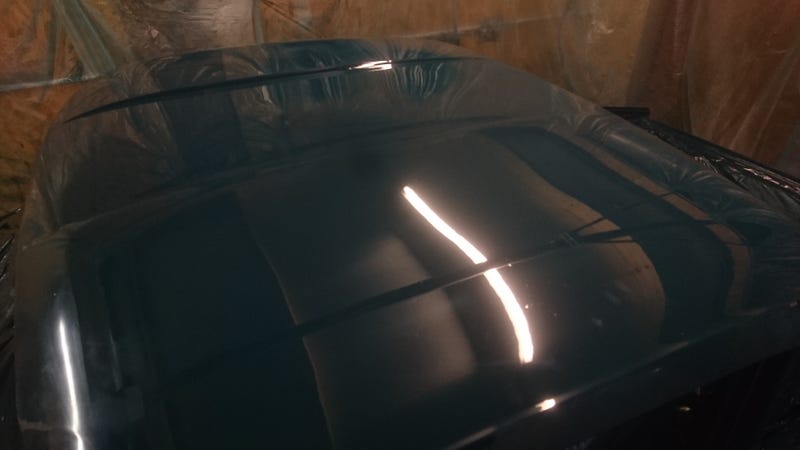 Lovely and glossy... 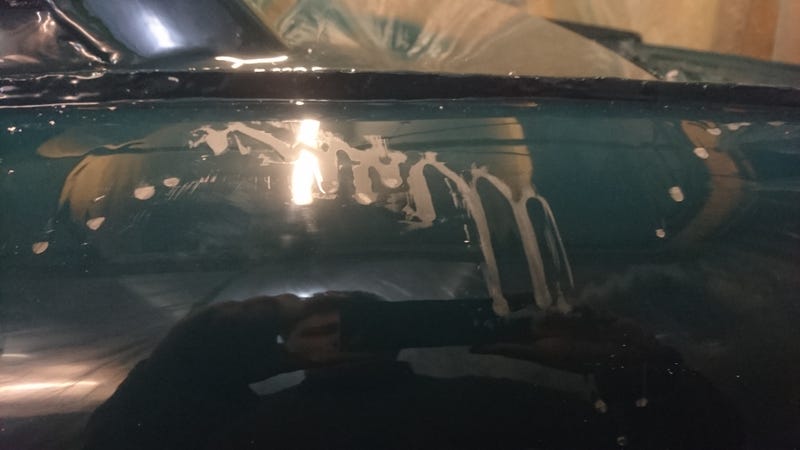 World's supply of runs (already started razoring them off here). I think part of the trouble is that because the temporary paint booth has no method of air extraction as soon as you start painting you can't see jack. Hopefully I've got enough thickness to sand them out and polish up, but I'm not overly hopeful. Steep learning curve this painting stuff... |
| |
|
|
|
|
|
|
|
Oct 24, 2018 15:54:25 GMT
|
|
Just finished the thread - great stuff!
Loved your Welsh trip write up, and total kudos for sharing your wiring diagrams.
Good luck with the paint. I've never done any so can only sympathise; looks like it's heading the right way though.
|
| |
|
|
|
|
|
Oct 25, 2018 22:15:11 GMT
|
Thanks man! Glad you've enjoyed the ride  Been working on the Fiat again recently. New AFM arrived, but didn't really change the running. Maybe it's running a little smoother, but it's still rich enough to make your eyes sting if you stand behind it. All this is exacerbated by the fact that we really don't have much clue as to what engine it actually has in there. It's got Mk1 UT exhaust, turbo and inlet, but a Mk2 distributor on the block (with a Mk1 cap on it) and the guy who sold it to me thought it was a 1400 (so Mk2). Need to check what the ingition and fuelling ECUs are. The engine number would probably tell me at least what block it is, but the crucial numbers are illegible. It starts with a 1 and ends in 000, which narrows it down to one of about a dozen possibilities. Something something other people's projects? |
| |
|
|
goldnrust
West Midlands
Minimalist
Posts: 1,889
|
|
Oct 25, 2018 22:35:02 GMT
|
|
Painting is a steep learning curve for sure, I've done 4/5 cars now at home and still feel a very long way from being able to do a decent job.
It sounds like you've put plenty of coats on, so a careful wet sanding and then final polish up shouldn't be a problem. Certainly all of my home paint jobs have relied upon a good wet and then compounding and polish to get a decent final finish, though normally because I've ended up with more orange peel than runs.
Rising rate fuel pressure regulators can and do work to supply extra fuel for upping boost. Some of the basic turbo kits for Mx5s use a RRFPR as their only method of managing the extra fuel needs of the engine while in boost. That how my first turbo mx5 started out, and it did work.
It's very rudimentary though and you're likely to end up with rich/lean spots across the rev range, or at different throttle points. While you will have extra fuel for boost, what it wont be able to do is retard the ignition timing to cope with the extra boost. In the case of my mx5 the only solution was to knock the base timing back to avoid knock in boost,, which made it sluggish off boost.
From experience I can say that affordable mapping options, such as a piggy back ECU or a cheap standalone system, like Megasquirt, will give you am much much more enjoyable car to drive than one using mechanical bodges to adjust fueling.
|
| |
|
|
|
|
|
Oct 30, 2018 13:42:49 GMT
|
Well a '4-cars, still not confident' doesn't bode well for the rest of mine  I've done some more reading about the rising rate regulators. Apparently they were popular for tuning these before you had access to affordable mappable engine management (especially for turbo cars). You can get them running pretty nicely with a T25 and an FSE regulator, except they lean out a little at the top end where the stock turbo starts running out of puff (so the stock ECU drops fuelling). Been pricing up T25s and head porting and second-hand ME221s. Think I can get it all done for £1500ish + mapping, and make 200-230bhp which would be very nice! At the moment I'd settle for just driving the thing... Oh, and the Uno Turbo management has a separate ignition ECU with a vac line that pulls timing as it builds boost. Pretty useful actually as you can just swap the fuel ECU if you want  Spit Update Spit UpdateWell, I've started flatting off the runs and the razor-blading worked an absolute treat for knocking them down prior to sanding. The only problem is that you have to have a very steady hand. I've slipped a couple of times, or accidentally run the blade along the paint rather than scraping it. This leaves deep cuts in the paint which unfortunately have gone beneath the lacquer layer (curse word). Plan now is to sand off the runs, and sand out the cuts, and then touch up the sanded areas with a little more gloss using my airbrush before final polishing (not that it's curing at all in this cold weather). Fiat UpdateSome more confusion with the Fiat as well. We noticed it was taking a long time to warm up so suspected the thermostat. Thought that might be fooling the temp sensor into thinking the engine was colder than it is. Turns out that opens fine, but I'll replace it with a new one anyway while it's apart. Did some more thorough testing and we're still perplexed. Water temp sensor seems to be within the figures in the Haynes manual at the relevant temperatures. Both AFMs also have the right resistances. What the what? Going to replace the coolant temp sensor anyway as I've already got one, but we're starting to run out of ideas. Fuel pressure is fine. Injectors don't seem to be leaking. Water temp is fine. AFM is fine. Throttle position and crank position tend to brick the car when they don't work so they're probably fine. Tried restricting the intake while it's running to listen for boost leaks but I can't seem to hear any. Any clever ideas? |
| |
Last Edit: Oct 30, 2018 13:43:08 GMT by biturbo228
|
|
|
|
|
Oct 31, 2018 12:06:02 GMT
|
|
Not clever, but?
Does it have a cam position sensor? On mine, if it fails, the engine will still run, using input from the other sensors and the ECU memory of the cam position when the sensor failed. All well and good, but it must drift over time?
|
| |
|
|
|
|
|
Oct 31, 2018 12:42:03 GMT
|
Interesting. I'll have a look. I'm not certain it does have a cam position sensor though, but it's a bit of a mongrel of bits so it might well do. Worth a shot! Oh, speaking of which. We did manage to decipher the engine number after much scotchbrighting. It is in fact a mk1 1.3l rather than the mk2 1.4l with 1.3l management it was sold as. This is actually a bit of a result as the 1.3l is supposed to be a bit of a better basis for tuning. As is typical I haven't yet found anyone actually saying why it is, but hey ho  |
| |
|
|
goldnrust
West Midlands
Minimalist
Posts: 1,889
|
|
|
|
Hopefully you'll get to the bottom fo the running problem soon, its horrible chasing issues like that. Been pricing up T25s and head porting and second-hand ME221s. Think I can get it all done for £1500ish + mapping, and make 200-230bhp which would be very nice! At the moment I'd settle for just driving the thing... As you're clearly the sort of hands on guy that likes having a go at these things yourself, I'd thoroughly recommend Megasquirt over the ME221. Solder a kit up yourself the old fashioned way and not only is is cheap, but you'll learn all about how and why it works in the process, which leaves you much better able to solve the sort of problems that always arise with DIY turbo set-ups. Building Megasquirt and learning to tune it has been one of the most rewarding things I've done with a car  |
| |
|
|
dw1603
Part of things
 
Posts: 591
|
|
|
|
|
Don’t want to p*ss on your strawberries, but I think the Spitfire is going to be considered “substantially changed” and will need some sort of IVA test to make it legal. Probably end up with a Q plate too.
|
| |
|
|
|
|
|
|
|
Don’t want to p*ss on your strawberries, but I think the Spitfire is going to be considered “substantially changed” and will need some sort of IVA test to make it legal. Probably end up with a Q plate too. A carefully worded email to the DVLA explaining the similarities between the early Spitfires and GT6's should resolve the engine swap. It'd be different if the owner had fitted a Rover v8 or some such into it. Simples  |
| |
|
|
dw1603
Part of things
 
Posts: 591
|
|
|
|
|
I am not an expert by any means, but I will be surprised (and delighted) if this one goes through on the nod. Good luck.
|
| |
|
|
|
|
 glad you're enjoying it.
glad you're enjoying it.
 I have learnt I was mixing the filler too rigarously, introducing bubbles which cause little pinholes, but I'm hoping to fix that with a smidge more filler. Went ok apart from that
I have learnt I was mixing the filler too rigarously, introducing bubbles which cause little pinholes, but I'm hoping to fix that with a smidge more filler. Went ok apart from that 
 glad you're enjoying it.
glad you're enjoying it.
 I have learnt I was mixing the filler too rigarously, introducing bubbles which cause little pinholes, but I'm hoping to fix that with a smidge more filler. Went ok apart from that
I have learnt I was mixing the filler too rigarously, introducing bubbles which cause little pinholes, but I'm hoping to fix that with a smidge more filler. Went ok apart from that 















